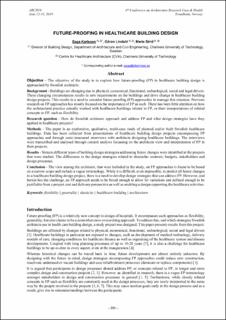| dc.description.abstract | Objective - The objective of the study is to explore how future-proofing (FP) in healthcare building design is approached by Swedish architects.
Background - Buildings are changing due to physical, economical, functional, technological, social and legal drivers. These changing circumstances results in new requirements on the buildings and drive change in healthcare building design projects. This results in a need to consider future-proofing (FP) approaches to manage this situation. Previous research on FP approaches has mostly focused on the importance of FP as such. There has been little attention on how the architectural practice actually worked with healthcare buildings related to FP, or their interpretations of related concepts to FP, such as flexibility.
Research question - How do Swedish architects approach and address FP and what design strategies have they applied in healthcare projects?
Methods - The paper is an explorative, qualitative, multi-case study of planned and/or built Swedish healthcare buildings. Data has been collected from presentations of healthcare building design projects encompassing FP approaches and through semi-structured interviews with architects designing healthcare buildings. The interviews were transcribed and analysed through content analysis focussing on the architects view and interpretation of FP in their projects.
Results - Sixteen different types of building design strategies addressing future changes were identified in the projects that were studied. The differences in the design strategies related to dissimilar contexts, budgets, stakeholders and design processes.
Conclusion - The view among the architects, that were included in the study, on FP approaches is found to be based on a narrow scope and include a vague terminology. While it is difficult, even impossible, to predict all future changes in a healthcare building design project, there is a need to develop design strategies that can address FP. However, and herein lies the challenge, an FP approach needs to be broad enough to allow for variations and defined enough to be justifiable from a project cost and delivery perspective as well as enabling a design supporting the healthcare activities. | |

